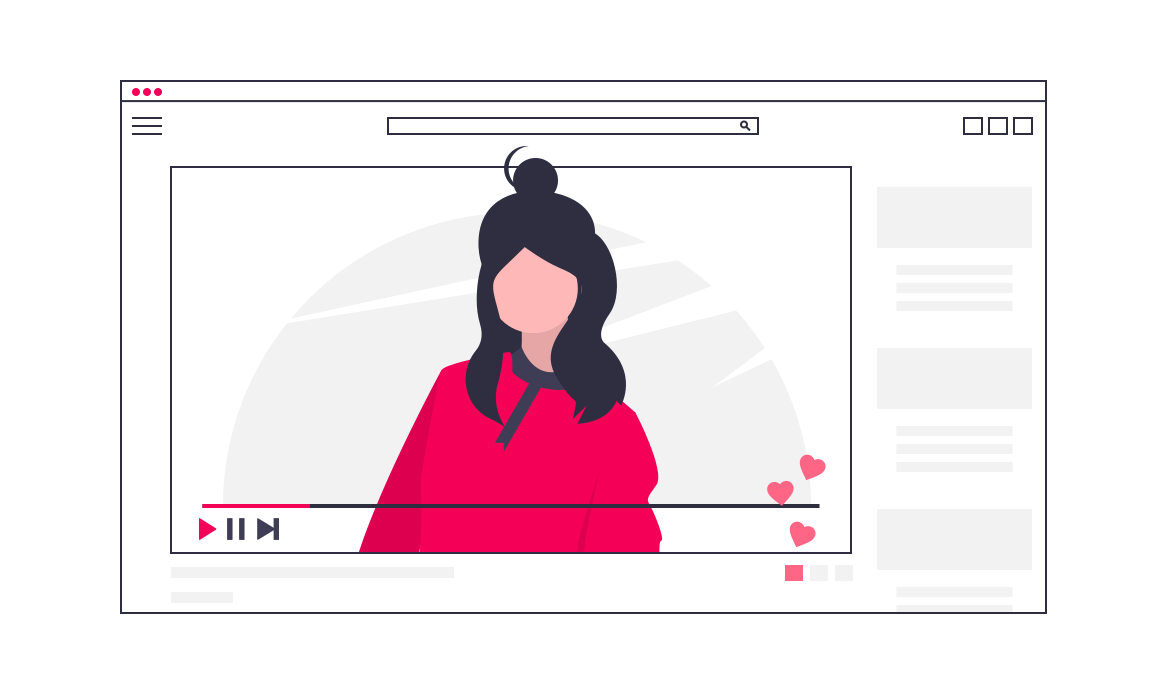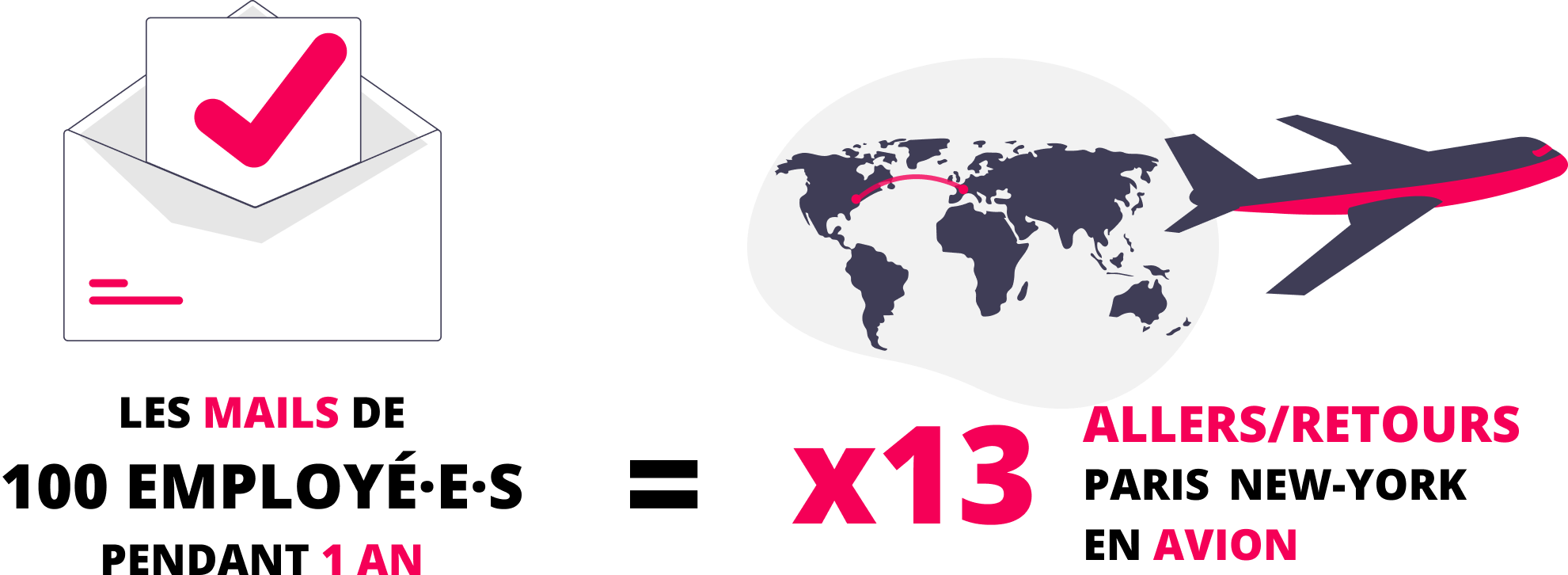Digital sobriety is an approach aimed at reduce the carbon footprint of digital, by adopting a reasoned use and by implementing more sober solutions in terms of energy.
This concept, which appeared about ten years ago, has gained momentum in recent years in response to the highlighting of the ecological impact of digital technology. Indeed, digital today represents 4% of greenhouse gases and its ecological footprint is nearly twice that of France.
 Terminals such as computers, televisions or smartphones are responsible for 45% of this footprint, and the remaining 55% comes from the use (Source: Lean ICT, The Shift Project 2018).
Terminals such as computers, televisions or smartphones are responsible for 45% of this footprint, and the remaining 55% comes from the use (Source: Lean ICT, The Shift Project 2018).
Several actors are campaigning for the digital is responsible, sustainable and trustworthy, and more than 150 large companies and public administrations have already joined the movement by registering with Cigref, an association bringing together large French companies and public administrations around digital technology.
It was further to one of the conferences organized by Cigref that I felt the urge to present to you one of the fruits of their labors: the benchmark for digital sobriety. I will then end with some key points discussed during this conference.
#1 What actions are concretely part of the digital sobriety approach?
To guide us in this process, Cigref and Syntec Digital – a French trade union for the digital industry – have jointly written a repository of digital sobriety. In their own words, this repository is a “common practical frame of reference for companies and their partners, created with the aim of equipping and raising awareness among teams and managers of the ethical issues of digital technology”.
Here is this reference frame summarized in 8 key axes:
- Strategy and management
- Define and implement a “Digital Sobriety” transformation plan for the entire company.
- Get the sponsorship leaders is an essential prerequisite for triggering a process of digital sobriety.
- Support for people and professions
- Supporting uses: bringing digital sobriety into the digital culture of organizations and defining an HR policy consistent with this objective.
- Raising awareness and training: developing awareness and the level of knowledge and training via specialized organisations.
- Responsible purchasing and life cycles
- Define an internal responsible purchasing policy that integrates the entire life cycle.
- Projects
- Translate the “digital sobriety” plan into the IS strategic plan: any new project must incorporate a “digital sobriety” dimension.
- Digital Services
- Take into account the sobriety of the company's internal digital services and in particular the work environment of employees.
- Ecosystems
- Evaluate, influence and act on its stakeholders. For example, during a call for tenders, take this into consideration or develop solutions with your current employees.
- Data
- Manage, evaluate and improve the energy consumption of usage and data flows in the company.
- Infrastructure
- Modernize technical infrastructures, ensure the optimization and energy sobriety of data centers, servers, storage, clouds IaaS (Infrastructure as a Service), PaaS (Platform as a Service), data transport and network.
- Modernize infrastructures and architectures: take into account their environmental impact, manage the life cycle of equipment.
To go further, Cigref has created, in partnership with The shift project - A think tanks French advocating the transition to a post-carbon economy – a report on digital sobriety. This aims to give the keys to organize a digital sobriety approach in large organizations, and in particular via their CIOs.
You can find out here methodology.
#2 Points covered during the colloquium by Cigref
 As part of the initiative Planet Tech'Care, Cigref organized a symposium at the end of November 2020 to present its benchmark and above all so that the various companies could provide feedback on the application of these methodologies.
As part of the initiative Planet Tech'Care, Cigref organized a symposium at the end of November 2020 to present its benchmark and above all so that the various companies could provide feedback on the application of these methodologies.
Among these companies we find in the order of appearance: L'Oréal; Ecology, Territories and Sea Ministries; The Shift Project, La Poste, Air-France KLM, AXA Group Operations, the Responsible Digital Institute, Octo Technology and Alliance Green IT.
In addition to the points previously addressed in the reference framework, these themes emerged from their sharing of experience:
- To succeed in having a reasoned use, it is essential that the question of product design be systematic.
Thinking about the product from the start with the users, choosing the functionalities that we develop or not. This end-to-end design with these questions of eco-design and accessibility is essential today. We will not succeed without these skills.
- The responsibility and commitment of companies is essential.
“No ecological transition without digital, we must support society in this movement.”
“The meaning we give to what we do, this meaning is embodied in the business, including in its services offered to customers.” - This approach is also part of a social and ethical framework.
- It is important to federate and raise awareness around this subject within the company, and this sometimes involves training.
- This adventure is impossible without sharing & collaboration.
“It is of paramount importance to share our feedback to move forward together, to propose commons, open source, in view of the climate emergency.”
- The most difficult today and the best lever for action is to measure the direct impact such as the rebound effects.
“Measure, measure, measure, if we don't measure, we are not credible.”
This last point was at the heart of the debate on the conversation associated with live stream, so crucial that it will be the subject of the working group for the year 2021. The other future ambitions are to develop a real “green IT” sector in France, in the professional world as well as at the Republic school.
To remember
It is possible and important today to register its digital projects within the framework of an environmental approach but also social and ethical. To facilitate this, it is advisable to rely on the existing community to benefit from their experience, and then to share your own.
Beyond the primordial aspect of the positive impact on the environment, the company gains value in the eyes of customers and future employees.
Finally, we should aim to stand to what really has value, to what we really need. This goes through product design which, so well realizeé, allows to develop only the necessary functionalities.
Take action!
More concretely, vHere are some courses of action and thoughts depending on your status:
- As a business: I find out about the work of Cigref and Syntech, I sign the Planet Tech'Care manifesto , I find out if I have motivation among my members to create a team on this subject.
- I ask myself: “How do I educate my employees?”
- As a developer or CIO: I optimize my code, the archiving as well as the purging of data. I lengthen the life of the code, I reduce it.
- I wonder: “to what extent the digitization of this process can generate an environmental gain?” “What is the environmental impact of this framework or infrastructure against celle-this?”
- As an individual: I limit the sending of attachments with collaboration files, I regularly clean my cloud and my emails, I keep my equipment as long as possible.
- I wonder: “does this application have a positive or negative impact on my behavior, my emotions?”, “do I need to change my device or can I repair it? Instead of throwing it away, is it possible to donate it to an association?”
- As designer: I challenge certain commonly accepted practices (autoplay on videos, make certain products addictive and not give an end to reading, etc.), I improve my user research, I educate myself beyond design (psychology, sociology, anthropology, etc.)
- I wonder “Should time on page and number of visits be my primary metrics of success?” “How will my product feel to someone with depression?” “Does my product encourage addictive behaviors?”
Do you wonder what the impact of your site, or that of others, is? You can test it here:
Links and Resources
The main players in digital sobriety:
Learn more about digital pollution and possible actions:
- Greenpeace talks about digital pollution
- Ademe offers you a practical guide to the hidden side of digital, and advice to reduce your impact
- A messaging service helps you pollute less with your emails
- Francetvinfo tells you about World Email Day
For the technical side:
- A thoughtbot article to create a greener site
- CSS Tricks goes deeper into the technical details
- And finally the essential Front-End performance guide by Smashing Magazine
And finally you designers and you curious, at ease with the language of Shakespeare or the deciphering of online translators, I strongly advise you to read this article on the “tech diet”
See you tomorrow for new surprises in our UX-Republic Advent calendar!
Orianne Dodinot, UI-UX Designer @UX-Republic
UX/UI ECO-DESIGN # Paris
SMILE Paris
163 quay of Doctor Dervaux 92600 Asnières-sur-Seine
DESIGN THINKING: CREATING INNOVATION # Belgium
UX-REPUBLIC Belgium
12 avenue de Broqueville - 1150 Woluwe-Saint-Pierre
MANAGING AND MEASURING UX # Paris
SMILE Paris
163 quay of Doctor Dervaux 92600 Asnières-sur-Seine
DESIGN SPRINT: INITIATION & FACILITATION # Paris
SMILE Paris
163 quay of Doctor Dervaux 92600 Asnières-sur-Seine
UX-DESIGN: THE FUNDAMENTALS # Belgium
UX-REPUBLIC Belgium
12 avenue de Broqueville - 1150 Woluwe-Saint-Pierre
GOOGLE ANALYTICS 4 #Paris
SMILE Paris
163 quay of Doctor Dervaux 92600 Asnières-sur-Seine
ACCESSIBLE UX/UI DESIGN # Belgium
UX-REPUBLIC Belgium
12 avenue de Broqueville - 1150 Woluwe-Saint-Pierre
EXPERIENCE MAPPING # Paris
SMILE Paris
163 quay of Doctor Dervaux 92600 Asnières-sur-Seine














